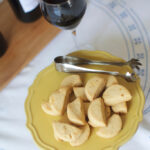Rosengarten Classic. Originally Published: ROSENGARTEN REPORT, September 2003.
There are many small decisions to be made when serving a cheese course; making the right choices adds immeasurably to your cheese enjoyment.
- What should be in the cheese course?
It can be as simple or elaborate as you wish. One great cheese, all by its lonesome, can be a cheese course. Or, you can bring together multiple cheeses; some people find that three is the limit if they wish to focus on the cheeses, others are happy to taste five or more. If you’re choosing multiple cheeses, there are two ways to go about it. You can bring together cheeses of the same type for a kind of comparison cheese course; I love tasting three or four goat cheeses together, for example, from different places, and at different ages. Or you can stress variety in a cheese course: for example, you can serve one goat, one hard sheep’s milk cheese, one runny-smelly cow’s milk cheese, one blue cheese.
- How do I present a cheese course?
The easiest way is to cut the cheese or cheeses into individual portions in the kitchen, place the cheese bits on plates, and serve the plates. But there is a much more elaborate option (and one which I favor): present a large cheese platter at the table, and cut the cheeses at the table. Find a rustic type of tray to put the cheeses on: straw, wood or wicker look great under cheese. If you want to go all the way, find leaves that can sit under the cheeses: hand-gathered ones in summer and fall, or vine leaves, or something from your florist called “galax.” Place each cheese on one leaf, and arrange the cheeses attractively on the platter. Bring a stack of plates to the table (one for each diner), as well as a sharp knife and a wet cloth. Tell your guests what cheeses you have, then ask each one which cheeses he or she would like (I always encourage ’em to taste every cheese.) Then, after taking one person’s “order,” cut the cheeses for that person and place the morsels on a single plate. Between each cut, wipe the knife on the wet cloth. Pass the completed plate, and go on to the next person.
- How do I cut cheese?
This is a crucial question—particularly when you have expensive cheeses at hand. Remember the general principle: cheese should be cut in such a way so that every diner gets a representative portion of the cheese. Most cheeses are round—and the part of the cheese at the center is usually very different from the part of the cheese closer to the rind. So…if you have a whole, round cheese…use “the pizza principle:” cut the cheese into triangular wedges that extend from the center to the edge. If you have a triangular wedge that was cut at the cheese store from a large round, visualize things in the same way. Do not cut a piece from the tip of the triangular wedge! Always cut along the side, from the pointy center back to the edge. Other cheeses…in other shapes, bring other challenges—but if you’re improvising, just remember to try and give everyone a piece that has the same basic components (equal amounts of rind, creamy center, etc.) A medium-length sharp knife works well for many cheeses.
- At what temperature should I serve cheese?
This is another crucial consideration. The general principle is: don’t serve it cold! I would recommend removing cheese from the refrigerator at least a few hours before you wish to serve it. The type of cheese I fuss over most, temperature-wise, is runny cheese; you need to make sure it’s warm enough to ooze (sometimes I take these babies out of the fridge in the morning, just to make sure they’re running by night).
- Do I eat the rind?
The answer is very simple: taste a little and decide for yourself. Sometimes, with smallish discs, the rind is the best part; I wouldn’t dream of cutting it off. But sometimes, even with a white, bloomy, attractive rind, you’ll get bitter tastes, or a taste of ammonia; don’t eat those rinds, obviously. Sometimes, with harder cheeses, it’ll be very apparent that you shouldn’t eat the rind: it may be so hard that you can’t chew through it! Again, there is no general answer to this question. Use your common sense—and be adventurous enough to give any rind a try! A small nibble won’t hurt you, even though it may not taste good.
Photos Via: Bigstockphoto, lindaraxa.blogspot.com, The Cheese and Wine Shop







